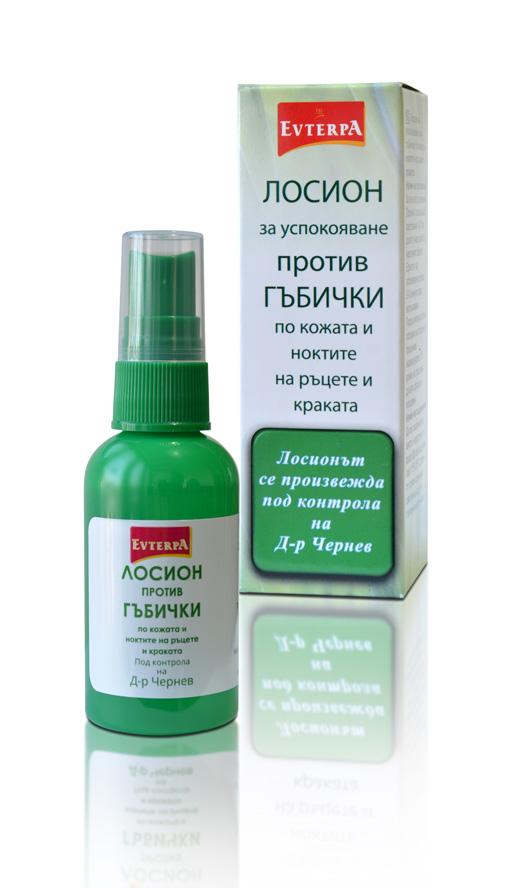Anti-Fungal Lotion for fingers and toes

Instructions for use:
For external use! Spray from a distance of 10-15 cm, until the skin areas are thoroughly dampened. The period of use depends on the size and location of the sectors affected by the fungus. It takes effect 5-10 minutes after spraying. Its healing effect occurs after 2-3 weeks of use.
The product is being manufactured under the supervision of Dr. Chernev.He graduates medicine in 1995 at Medical Unviersity of Plovdiv.Since then he works at Evterpa Company and provides its clients with high quality products,long-lasting effect and satisfaction.
There are different world monografies and studies about the components, that we use in the antifungal lotion and we will now tell you shortly about each ingredient.
1. Aqua and Ethyl alcohol denat. are solvents and the ethyl alcohol itself is also use as a local desinfectant on the damaged nail.
2. Glycerin is humectant and has a hydration role.
3. Salicylic acid has anti-fungal properties and can be used to eliminate tinea, a fungus involved in various types of skin infections. Salicylic acid can eliminate tinea versicolor, an infection of the top layer of the skin that causes scaly, discolored patches; tinea pedis (athlete's foot); tinea cruris (jock itch); tinea corporis (ringworm of the body) and tinea capitis (ringworm of the scalp). Salicylic acid destroys fungi by suppressing their ability to grow or reproduce.
4. Benzoic acid - Candida albicans is an important opportunistic fungal pathogen capable of provoking infection in humans. The effect of benzoic acid is evaluated against 3 C. albicans strains (ATCC-76645, LM-106 and LM-23). Benzoic acid inhibits the growth of mold, yeast and some bacteria. Benzoic acid and its salts are used as a food preservatives, because it is totally safe.
5. PEG-40 Hydrogenated castor oil- this is a solubilizer for some fine particles.
6. Eugenia Caryophyllus (Clove) Flower Oil- it is known for its natural antifungal effect. This is the bio compound in harmony with all the science.
7. Urea - Urea has long been an effective and safe treatment modality for numerous dermatologic disorders. The use of urea for the management of damaged, devitalized, dystrophic and mycotic nails is well documented. The mechanism of action of urea in the nail unit is based on the fact that urea exerts keratolytic and moisturizing effects by breaking hydrogen bonds. This subsequently loosens keratin and increases water-binding sites. Given urea’s keratolytic effects, physicians have used it in the treatment of onychomycosis. Numerous studies have shown combination therapy of urea and an antifungal agent to be an effective treatment for onychomycosis. Urea functions to soften the nail plate, which can enhance the passage of antifungal medications to the underlying nail bed. The safety and efficacy of urea in numerous dermatologic disorders is well documented. With keratolytic and moisturizing mechanisms of action, urea is very useful in the treatment of both skin and nail disorders. Specifically, urea has been a successful treatment modality for onychomycosis as well as an effective agent for chemical nail avulsion.
8. Sodium benzoate- The fungal infection is always accompanied by leggings, molds and bacteria. Sodium benzoate works against various spectrum of microorganisms: Bacillus mucoides; Bacillus subtilis; Staphylococcus a.; Pseudomonas aer.; Escherichia coli; Aspergillus flavus; Candida albicans; Fusarium oxy.; Trichoderma hars; Penicillium italicum.
9. D-panthenol - it has the ability to calm the skin and nourish the skin because it is a provitamin B5.
10. Propylene glycol - it has a softening effect and it is co-solvent.
11. Climbazole - Climbazole is an imidazole antifungal agent.It is a topical antifungal agent commonly used in the treatment of human fungal skin infections such as dandruff and eczema.Climbazole works by inhibiting ‘lanosterol 14α-demethylase’, the enzyme responsible for producing steroids needed to maintain fungi cell membranes.
12. Triclosan - It is specific antibacterial agent, because if there is a fungal infection there is also bacteria infection. At high concentrations, triclosan acts as a biocide with multiple cytoplasmic and membrane targets. However, at the lower concentrations, seen in commercial products, triclosan appears bacteriostatic, and it targets bacteria primarily by inhibiting fatty acid synthesis.
13. Piroctone Olamine - Piroctone olamine is an antifungal active ingredient, soothes inflamed skin and reduces flaking. It has a specific action against Pityrosporum Ovale, the agent responsible for the production of some fungus. The antifungal product containing piroctone olamine destroys the fungus infection and works against the formation of new fungus, makes the skin stay clean, itch free and prevents the formation of new illnes.
14. EDTA - Stabilizer of the system, antioxidant and helator.
Storage:
Keep out of reach of children. Keep at 5-25°C away from direct sunlight and other heat sources.



